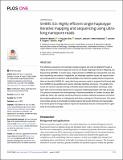SHIMS 3.0: Highly efficient single-haplotype iterative mapping and sequencing using ultra-long nanopore reads
Author(s)
Bellott, Daniel W; Cho, Ting-Jan; Jackson, Emily K; Skaletsky, Helen; Hughes, Jennifer F; Page, David C; ... Show more Show less
DownloadPublished version (1.939Mb)
Publisher with Creative Commons License
Publisher with Creative Commons License
Creative Commons Attribution
Terms of use
Metadata
Show full item recordAbstract
<jats:p>The reference sequence of structurally complex regions can only be obtained through a highly accurate clone-based approach that we call Single-Haplotype Iterative Mapping and Sequencing (SHIMS). In recent years, improvements to SHIMS have reduced the cost and time required by two orders of magnitude, but internally repetitive clones still require extensive manual effort to transform draft assemblies into reference-quality finished sequences. Here we describe SHIMS 3.0, using ultra-long nanopore reads to augment the Illumina data from SHIMS 2.0 assemblies and resolve internally repetitive structures. This greatly minimizes the need for manual finishing of Illumina-based draft assemblies, allowing a small team with no prior finishing experience to sequence challenging targets with high accuracy. This protocol proceeds from clone-picking to finished assemblies in 2 weeks for about $80 (USD) per clone. We recently used this protocol to produce reference sequence of structurally complex palindromes on chimpanzee and rhesus macaque X chromosomes. Our protocol provides access to structurally complex regions that would otherwise be inaccessible from whole-genome shotgun data or require an impractical amount of manual effort to generate an accurate assembly.</jats:p>
Date issued
2022Department
Massachusetts Institute of Technology. Department of BiologyJournal
PLoS ONE
Publisher
Public Library of Science (PLoS)
Citation
Bellott, Daniel W, Cho, Ting-Jan, Jackson, Emily K, Skaletsky, Helen, Hughes, Jennifer F et al. 2022. "SHIMS 3.0: Highly efficient single-haplotype iterative mapping and sequencing using ultra-long nanopore reads." PLoS ONE, 17 (6).
Version: Final published version